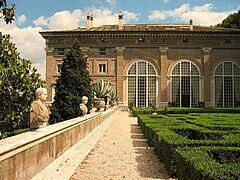Villa Madama
| Villa Madama | |
|---|---|

Garden with Raphael's loggia
|
|
| General information | |
| Town or city | Rome |
| Country | Italy |
| Coordinates | 41°55′42″N 12°27′10″E / 41.928353°N 12.452781°E |
| Construction started | 1518 |
| Completed | 1525 |
| Client |
Cardinal Giulio de' Medici Prime Minister of Italy |
| Design and construction | |
| Architect |
Raphael Antonio da Sangallo the Younger |
Villa Madama is a prominent rural house or villa built during the Renaissance.
The villa situated half way up the slope of Monte Mario to the west of Rome, Italy, a few miles north of the Vatican, and just south of the Foro Olimpico Stadium. Even though incomplete, this villa with its loggia and segmented columned garden court and its casino with an open center and terraced gardens, was highly influential for subsequent architects of the High Renaissance.
Cardinal Giulio de' Medici, cousin of the reigning pontiff Leo X, commissioned the initial design of the villa from Raphael. Raphael died at the age of 37 in 1520, with work at the villa far from completed, and construction, started in 1518, passed on to his disciples, one of the most brilliant teams ever assembled on a site, although without Raphael to smooth over disputes, they quarreled incessantly. Antonio da Sangallo the Younger produced the final plans and supervised the actual construction, though who is responsible for which details of the design remains cloudy.
The decorations are by Giulio Romano and Baldassare Peruzzi, both major architects in their own right; Giovanni da Udine completed the stucco bas-reliefs imitating work found in Nero's recently rediscovered Domus Aurea; and finally, both Giovan Francesco Penni ("il Fattore") and the Florentine sculptor Baccio Bandinelli worked there too. Aside from the Raphael loggia, the villa's greatest artistic element is the salone painted by Giulio Romano, with its magnificent vaulted ceiling. After Giulio de' Medici became the second Medici pope, as Clement VII in 1523, work resumed in 1524-1525 only to stop again in 1527 during the Sack of Rome. During this time, the villa suffered damage. While parts of it were rebuilt, the villa was never completed.
...
Wikipedia
